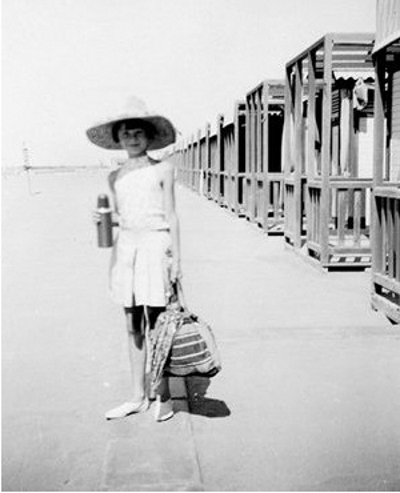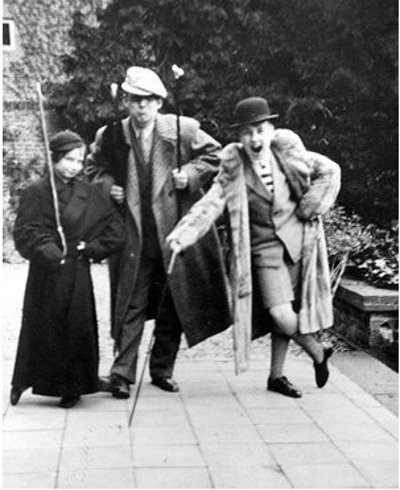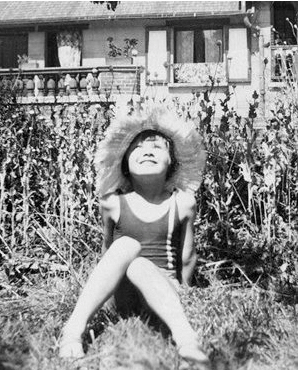All of the artwork in this post was done by Audrey Hepburn during World War II.

Audrey at the beach in 1937, 8 years old, before the war.Living is like tearing through a museum. Not until later do you really start absorbing what you saw, thinking about it, looking it up in a book, and remembering — because you can’t take it all in at once.
In 1939, Audrey Hepburn’s mother Ella moved Audrey and her two half-brothers from Belgium to their grandfather’s home in Arnhem, in the Netherlands. She believed they would be safe there. On May 10, 1940, six days after Audrey’s eleventh birthday, the Wehrmacht invaded the Netherlands, having already come through Luxembourg and Belgium. The Germans called their campaign of invasion of the Low Countries “Fall Gelb;” in Dutch, the Nederlanders refer to it as “Slag om Nederland,” or, “Battle for the Netherlands.”

Audrey passed much of her time outside of school during the occupation drawing.
Completely hemmed in and outmanned by the German army, the Dutch main force in the Netherlands nonetheless held out for five days in mid-May, 1940 — a small contingent near Zealand held off the Wehrmacht through the 17th, but finally surrendered after grave loss of life. Almost exactly five years later, the final Dutch province was liberated.
During the five-year occupation of Arnhem, besides spending her time drawing and performing openly in plays with her mother and friends, Audrey attended school under the name “Edda van Heemstra,” a pseudonym invented by her mother Ella that she hoped would not betray Audrey’s English roots.

Audrey in costume for one of the plays in which she and Ella performed to raise spirits in the town during the occupation.
Audrey trained in ballet and secretly performed for small, sympathetic groups to raise money for the Dutch Resistance.
“The best audience I ever had made not a single sound at the end of my performances.”

1939 — age 10.
I was exactly the same age as Anne Frank. We were both 10 when war broke out and 15 when the war finished. I was given the book in Dutch, in galley form, in 1946 by a friend. I read it and it destroyed me. It does this to many people when they first read it, but I was not reading it as a book, as printed pages. This was my life. I didn’t know what I was going to read. I’ve never been the same again, it affected me so deeply.
During the Dutch famine over the winter of 1944, the Germans confiscated the Dutch people’s limited food and fuel supply for themselves. Without heat in their homes or food to eat, people in the Netherlands starved and froze to death in the streets. Hepburn and many other Dutch people had to resort to using flour made from tulip bulbs to bake cakes and cookies.
Arnhem was devastated during allied bombing raids that were part of Operation Market Garden. Audrey’s older brother Ian was sent to a labor camp, and her uncle and cousin were shot in front of her for being part of the Resistance.

Audrey and her brothers Anthony and Ian playing in 1938.
We saw reprisals. We saw young men put against the wall and shot and they’d close the street and then open it and you could pass by again. If you read the diary [of Anne Frank], I’ve marked one place where she says, ‘Five hostages shot today’. That was the day my uncle was shot. And in this child’s words I was reading about what was inside me and is still there. It was a catharsis for me. This child who was locked up in four walls had written a full report of everything I’d experienced and felt.

In Belgium in 1934, five years before the war broke out.
I have memories. More than once I was at the station seeing trainloads of Jews being transported, seeing all these faces over the top of the wagon. I remember, very sharply, one little boy standing with his parents on the platform, very pale, very blond, wearing a coat that was much too big for him, and he stepped on to the train. I was a child observing a child.
When the tanks came in and the country was liberated, United Nations Relief and Rehabilitation Administration trucks followed. Hepburn said in an interview that she ate an entire can of condensed milk and then got sick from one of her first relief meals because she put too much sugar in her oatmeal. This experience is what led her to become involved in UNICEF late in life. (source)

My own life has been much more than a fairy tale. I’ve had my share of difficult moments, but whatever difficulties I’ve gone through, I’ve always gotten a prize at the end.
Donate to the Audrey Hepburn Children’s Fund, online via PayPal, by phone at 310.393.5331, or through the mail to The Audrey Hepburn Children’s Fund, 710 Wilshire Blvd., Suite 600, Santa Monica, CA 90401.
Update 1/27/2012: Contact info for the AHCF update:
Audrey Hepburn Children’s Fund
65 S. Grand Avenue – First Floor – Pasadena – CA 91105
phone 1.626.304.1380
fax. 1.626.304.1386
email ahcf@audreyhepburn.com





